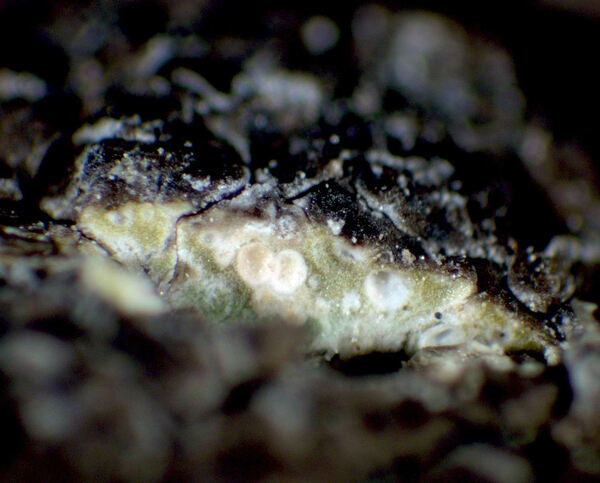Heteroplacidium zamenhofianum (Clauzade & Cl. Roux) Cl. Roux
in Roux & al., Bull. Soc. linn. Provence, 60: 172, 2009. Basionym: Verrucaria zamenhofiana Clauzade & Cl. Roux - Bull. Soc. Bot. Centre-Ouest, n. sér., nr. spéc. 7: 823, 1985.
Synonyms: Dermatocarpon compactum sensu Clauzade & Rondon
Distribution: N - Frl (vidi!), Ven (Nimis 1994), TAA (Nascimbene & al. 2022), Piem (TSB 34795), VA (TSB 29429), Lig.
Description: Thallus crustose, areolate-subsquamulose, dark brown to almost black, 0.2-0.7 mm thick, parasitic on Staurothele areolata. Areoles 0.6-1.5 mm wide, finely crenulate-lobulate, crowded and fitting together like a puzzle, or with slightly overlapping margins, smooth and slightly glossy. Upper cortex well delimited, 20-25 µm thick, the uppermost cell layer with brown pigment, sometimes overlain by a very thin epinecral layer; medulla subparaplectenchymatous; lower cortex limited to the marginal part of areoles, 20-40 µm thick, paraplectenchymatous, pale brown, with granular inspersions, below with colourless, 3-4.5 µm thick rhizohyphae. Perithecia totally immersed; exciple subglobose, 0.18-0.27 mm across, the wall colourless; involucrellum lacking; paraphyses absent, substituted by simple periphyses. Asci 8-spored, clavate, I-, fissitunicate, the wall thickened above, Verrucaria-type. Ascospores 1-celled, hyaline, broadly ellipsoid to subglobose, 10-12 x 9-10 µm. Pycnidia immersed, inconspicuous, of the Dermatocarpon-type. Conidia bacilliform. Photobiont chlorococcoid (Myrmecia. Spot tests: cortex and medulla K-, C-, KC-, P- UV-. Chemistry: without lichen substances.Note: a species with a crustose, dark brown thallus with incised to sublobate areoles, growing on taxa of the Staurothele areolata-group on slightly inclined to subhorizontal surfaces of calcareous rocks in upland areas; widely distributed in Europe and North America, as well as in the Alps, it is easy to overlook due to the thalli of host and parasite being concolorous. To be looked for in the Central Apennines.
Growth form: Crustose
Substrata: rocks
Photobiont: green algae other than Trentepohlia
Reproductive strategy: mainly sexual
paras Staurothele areolata
Commonnes-rarity: (info)
Alpine belt: rather common
Subalpine belt: rather rare
Oromediterranean belt: absent
Montane belt: absent
Submediterranean belt: absent
Padanian area: absent
Humid submediterranean belt: absent
Humid mediterranean belt: absent
Dry mediterranean belt: absent

Predictive model
Herbarium samples
Growth form: Crustose
Substrata: rocks
Photobiont: green algae other than Trentepohlia
Reproductive strategy: mainly sexual
paras Staurothele areolata
Commonnes-rarity: (info)
Alpine belt: rather common
Subalpine belt: rather rare
Oromediterranean belt: absent
Montane belt: absent
Submediterranean belt: absent
Padanian area: absent
Humid submediterranean belt: absent
Humid mediterranean belt: absent
Dry mediterranean belt: absent

Predictive model
| Herbarium samples |
 Index Fungorum
Index Fungorum
 GBIF
GBIF




